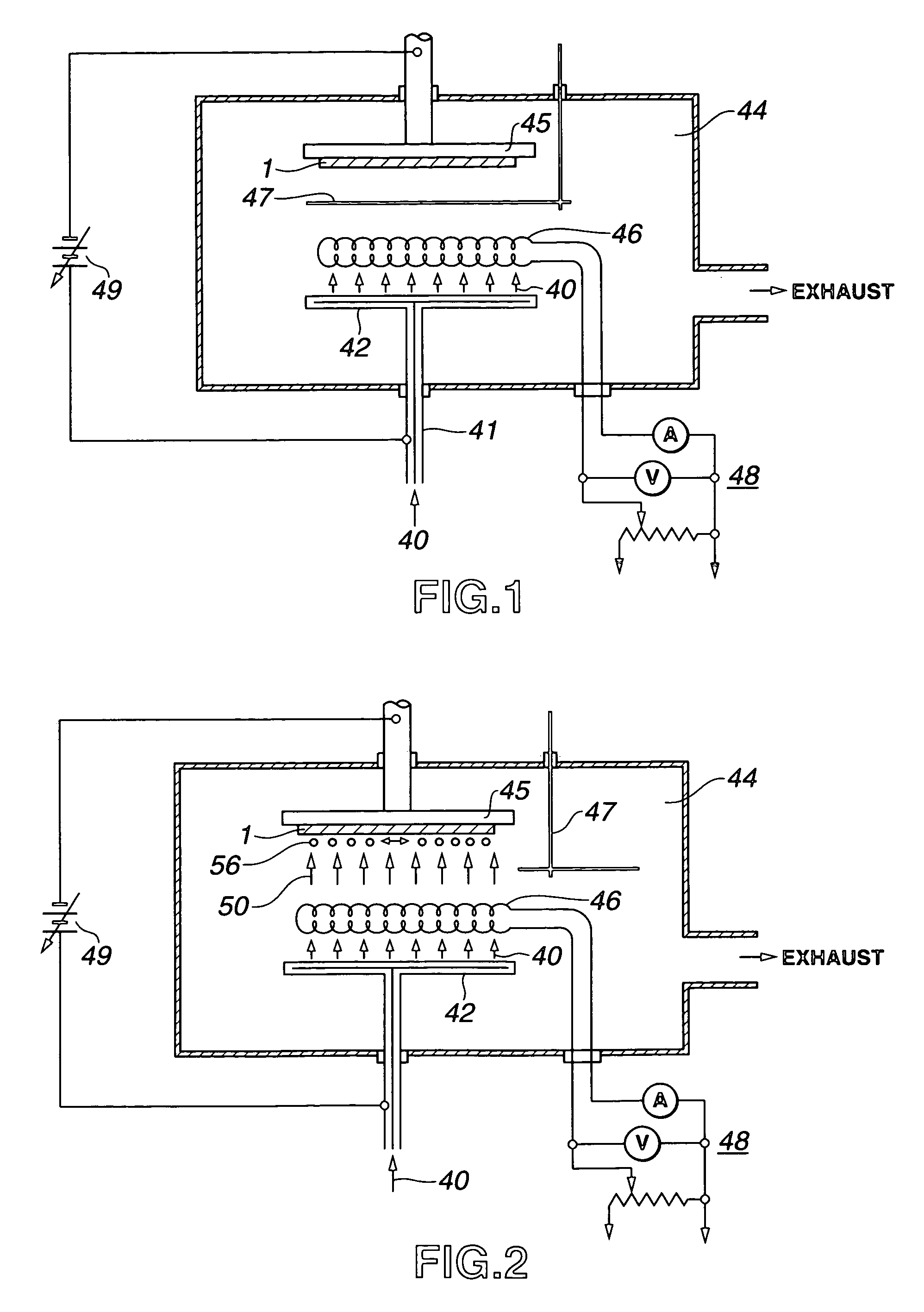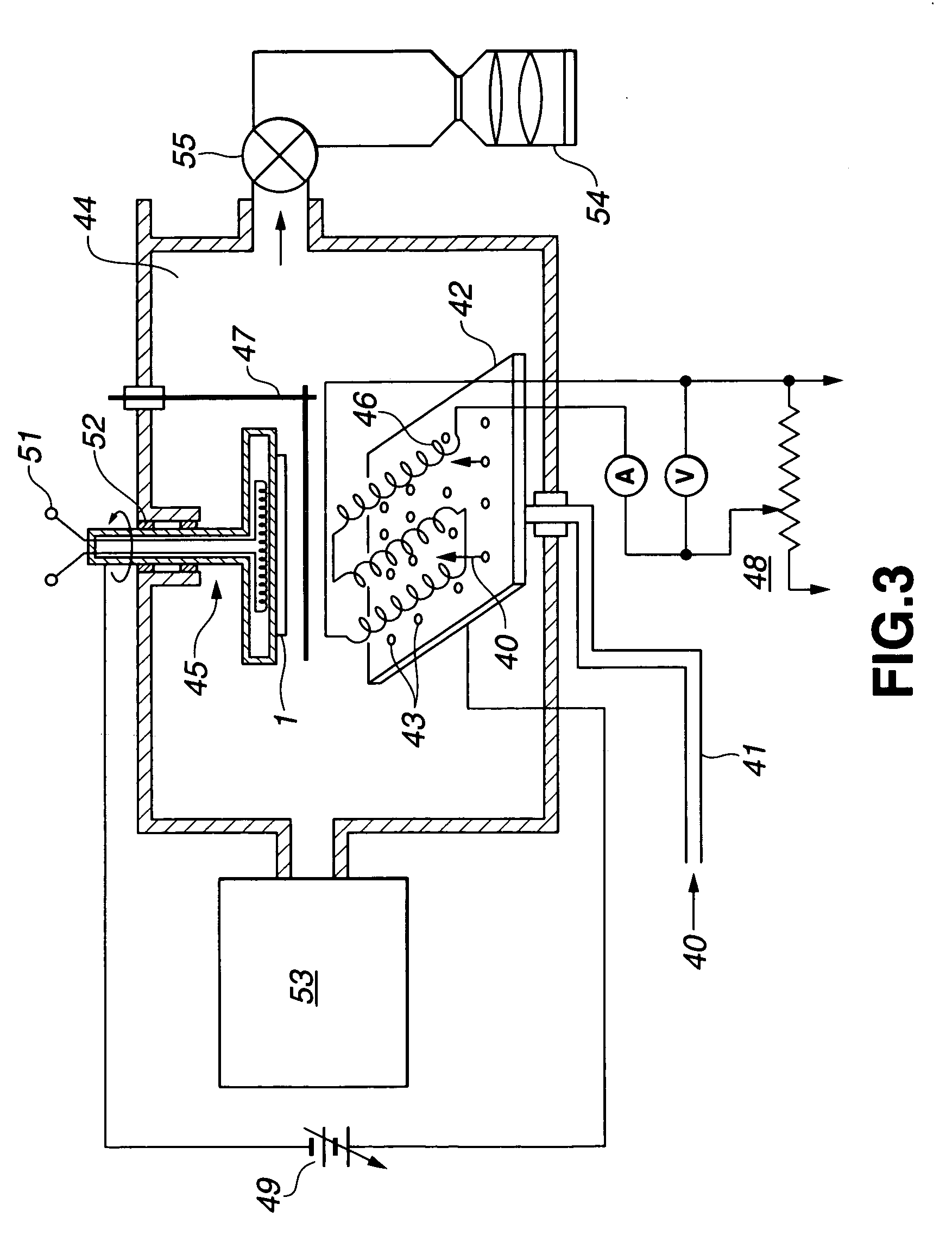Method and apparatus for film deposition
a film forming and film technology, applied in chemical vapor deposition coatings, coatings, metallic material coating processes, etc., can solve the problems of damage and short circuit of transistors, film forming methods, and ultraviolet damage, and achieve high utilization efficiency of reaction gas, efficient deposited, and high forming speed
- Summary
- Abstract
- Description
- Claims
- Application Information
AI Technical Summary
Benefits of technology
Problems solved by technology
Method used
Image
Examples
first embodiment
[0086]A first embodiment of the present invention will be described with reference to FIGS. 1 to 10.
[0087]In the present embodiment, on the basis of the catalyzed CVD method, a reaction gas, made of a hydrogen-based carrier gas and a material gas such as a silane gas or the like, is brought in contact with a heated catalyzer made of tungsten or the like, and an electric field of not higher than a glow discharge starting voltage is caused to act on the radical deposition species or its precursor thus produced and radical hydrogen ions, thus providing kinetic energy. Thus, a predetermined film of polycrystal silicon or the like is formed by vapor growth on a substrate. In this case, a DC voltage not higher than the glow discharge starting voltage, that is, a DC voltage determined by the Paschen's law, for example, a voltage not higher than 1 kV is applied between the substrate and a counter-electrode, thus directing the radical deposition species or its precursor and radical hydrogen ...
second embodiment
[0133]A second embodiment of the present invention will now be described with reference to FIG. 7.
[0134]In the present embodiment, using the DC-bias catalyzed CVD method and the device therefor of the first embodiment, charged particles or ions are provided, that is, an electron shower 100 is provided near a substrate 1 or a suscepter 45 as shown in FIG. 7. Therefore, in addition to the effect of the first embodiment, an excellent effect can be realized as follows.
[0135]At the time of or during the formation of the above-described polycrystal silicon film, radical deposition species of high energy or their precursors and ions might be generated in the reaction gas due to catalytic action of a catalyzer 46, and charge up the substrate 1, thus causing unevenness in the film formation and deterioration in the performance of the film or device. However, by irradiating the ions and the like with electrons having directionality and concentration due to a DC field from the electron shower ...
third embodiment
[0136]A third embodiment of the present invention will now be described with reference to FIG. 8.
[0137]In the present embodiment, a mesh electrode 101 for accelerating reactive species is provided between a substrate 1 and a catalyzer 46 as shown in FIG. 8, in the DC-bias catalyzed CVD method and the device therefor of the first embodiment.
[0138]Specifically, a plurality of mesh electrodes 101a and 101b having gas passage holes 101c are provided between the substrate 1 and the catalyzer 46, and a DC voltage 49 not higher than 1 kV is applied between them, thereby providing kinetic energy in the direction toward the substrate 1 to the reactive species generated by decomposition of the reaction gas due to the catalyzer 46 as described above. Therefore, in addition to the effect similar to that of the first embodiment, an accelerating electrode which is designed and processed in advance can be easily inserted as the mesh electrode 101 into the gap between the substrate 1 and the cataly...
PUM
| Property | Measurement | Unit |
|---|---|---|
| frequency | aaaaa | aaaaa |
| temperature | aaaaa | aaaaa |
| temperature | aaaaa | aaaaa |
Abstract
Description
Claims
Application Information
 Login to View More
Login to View More - R&D
- Intellectual Property
- Life Sciences
- Materials
- Tech Scout
- Unparalleled Data Quality
- Higher Quality Content
- 60% Fewer Hallucinations
Browse by: Latest US Patents, China's latest patents, Technical Efficacy Thesaurus, Application Domain, Technology Topic, Popular Technical Reports.
© 2025 PatSnap. All rights reserved.Legal|Privacy policy|Modern Slavery Act Transparency Statement|Sitemap|About US| Contact US: help@patsnap.com



